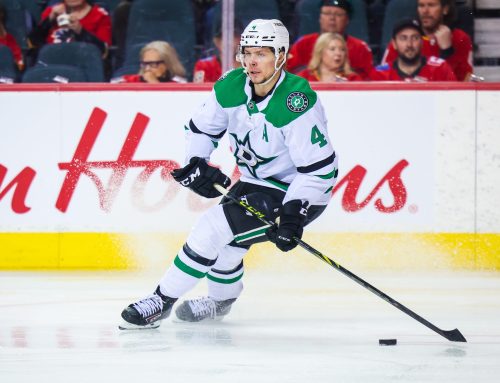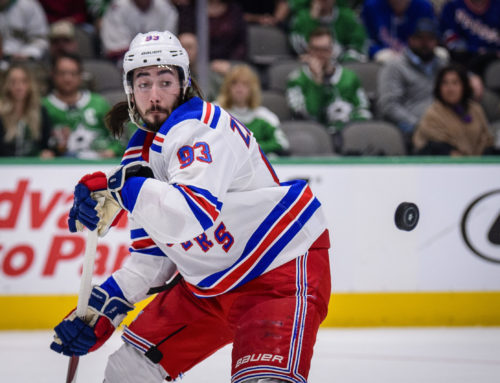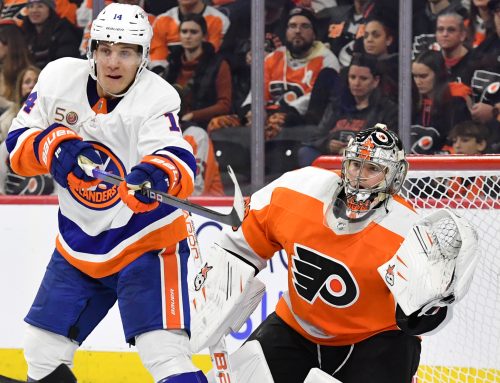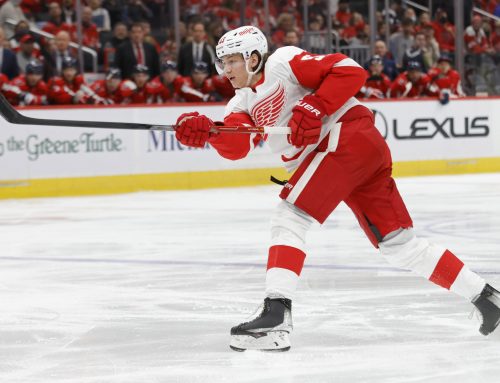Goldipucks and the Three Skaters: Vegas Baby Part 1
Rick Roos
2018-02-28

Goldipucks and the Three Skaters, featuring the Golden Knights
Welcome to this season’s third installment of Goldipucks and the Three Skaters! For first time readers, or those who missed the most recent installment, the concept is a play on Goldilocks and the Three Bears, except instead of bowls of porridge I’m covering skaters and declaring one too hot (i.e., doing unsustainably better than he should), another too cold (i.e., doing unsustainably worse), and a third “just right” (i.e., producing where he should). Each skater also receives a 1-10 rating, indicating, on a relative scale, how hot (rated 7-10, where 10 is the most unsustainably hot), cold (rated 1-3, where 1 is the most unsustainably cold), or just right (rated 4-6, where 5 is the most “just right”) he is.
Last time I focused solely on defensemen; the theme this week – and next – is “Vegas Baby!” as I’m covering only skaters from this year’s NHL (and fantasy) surprise team, the Golden Knights. Chances are several Vegas skaters are making an impact in your league, with the question being what to expect from them between now and game 82. Goldipucks is here to give you the lowdown on who’s too hot, too cold, and just right from the Golden Knights.
Did you notice I said this week and next? There are too many Vegas players to cover in just one week, so this week I’m starting with Jonathan Marchessault, Colin Miller, and Nate Schmidt, and then next week I’ll be back with three more of their skaters! Before you read any further, be sure to guess which player I’m covering this week is too hot, which is too cold, and which is just right. It’s a fun game to play, but also important in that it confirms whether your “spidey senses” are correct, and, if they aren’t, allows you to determine what might have led your instincts astray.
Jonathan Marchessault (data for Marchessault and other players through February 25)
The diminutive Marchessault has chugged along at a point per game or better pace all season, even now as we’ve arrived at the final quarter of the campaign. But can it last? Can he really finish at or above the point-per-game level when all is said and done for 2017-18? Yes he can, and almost assuredly will.
Marchessault was playing at this level during chunks of 2016-17 for Florida in posting 51 points, and even in 2015-16 on Tampa he showed flashes of top play – including a seven-game point streak – despite being a frequent healthy scratch and finishing with only 18 total points in 41 games. Accordingly, he looked to be a perfect fit for Las Vegas, where he was all but guaranteed a scoring role, and sure enough he’s delivered top production.
But can we expect him to keep up this pace? After all, his ice time per game is up only slightly from last season, while taking the ice for less than 50% of his team’s PP minutes this season, plus less PP TOI per game than in Tampa or Florida, and on top of that sporting a team shooting percentage of 11.06%.
Probably the biggest key suggesting his production is sustainable is his already healthy SOG rate spiking to 3.43 per game (from 2.54 last season) combined with a drop of 10% in average shot distance (from last season’s already low 34 feet). Also, although his team shooting percentage is indeed high, if the league average among top nine forwards is roughly 9% and some are well below that number, that means others must be above it; and for him to be at this level this late in the season suggests he might just be someone who can – and does – run high in that area.
Moreover, there are factors which would offset a production decline based on his team shooting percentage falling. For one, only 14 of his 39 assists have been secondary, which means if anything he has room to see an uptick in helpers. Beyond that, he has 45 SOG on the PP, and each and every forward with more PP SOGs has more PPPts than his 14, so that too might be an area to see some organic growth between now and game 82. Also, his IPP is holding steady from last season despite him now playing with more talented players, which means he’s maintained his nose for scoring.
And although it’s true that his total ice time per game would be lower than all but four of the 189 forwards who scored 80+ points in 70+ games in at least one season since 2000-01, keep in mind that Vegas has very defined roles for its players, with several of its scorers – including Marchessault – having little to no PK time, which in turn means every minute he’s out there he’s trying to score, as opposed to many of the 80+ point scorers who had more minutes but a good chunk of which were spent on the PK.
All things considered, Marchessault’s scoring rate is JUST RIGHT, and he gets a rating of 4.75 since the number and type of factors which suggest he could up or maintain his production rate roughly cancel out (if not slightly override) those which indicate his rate could decline.
Once a key piece in the deal that brought Milan Lucic from Boston to LA, Miller produced a mere 29 points in 103 total games with Boston, making it not a shock to see him exposed in the expansion draft this past summer. With Vegas, the still only 25-year-old Miller has found himself the leader in rearguard scoring on a team that includes not only the highly touted Shea Theodore but also Nate Schmidt, who’s also being covered this week (see below).
So can Miller keep up his 44 point pace? Most likely no. For starters, it turns out 11 of his 13 PPPts have come when paired with Brad Hunt. The problem is Hunt is about as one-dimensional of a defenseman as there is, and as such has appeared in barely half of Vegas’ games to date. As the season rolls on, and Vegas gears up for the playoffs, look for Hunt to dress even less often, and, in turn, for Miller’s PP production to suffer.
Miller’s IPP also is 51.6%, which, although indicative of a player who’s dialed into scoring, is definitely high for a still unproven d-man. Yet he’s also managed more primary assists than secondary, which makes the IPP number less unrealistic. Still, all this has come with an offensive zone starting percentage of 62%, and Vegas either will need to lean more on their well-rounded d-men as they focus on readying for the playoffs, meaning Miller gets fewer minutes, or Miller will have to play a more complete game. In either case, however, his scoring rate might suffer.
Moreover, although he’s 25 years old, Miller has never played more than 61 games in a professional season. What that means is the rigors of a full 82-game campaign are likely to take a toll even with his sheltered minutes. In fact, that might already be happening, as thus far in February Miller has only 17 SOG in 12 games, which is a far cry his 2.32 SOG per game rate through January.
Overall, Miller is TOO HOT, since although he’s shown enough to command a regular shift it’s been with a high OZ%, plus his PP production is at risk of drying up and he’s heading into uncharted territory in terms of games played for a single season. He gets a rating of 9.0, with the expectation that he’ll be lucky to post much more than a handful of points over his final 21 games.
It hasn’t been quite the breakout season for Schmidt that many poolies envisioned; however, brighter things likely lie ahead. While the aforementioned Miller is arguably the more offensively gifted d-man, Schmidt has something Miller doesn’t – 21 games of career playoff experience (versus a mere four for Miller), not to mention better two-way abilities. Vegas surely realizes this, and appears to be already shifting the focus more toward Schmidt with each passing game in this final quarter of the season.
Case in point – Schmidt took the ice for 40%+ of the team’s PP minutes in Vegas’ four prior games, marking the first time that’s happened since December. Another key is Schmidt’s best success on the PP has come when the team runs a PP1 unit consisting of 1D and 4F, whereas Miller has produced most of his PPPts when he’s been paired with Hunt. Chances are as the playoffs near Vegas will prefer to trot out a PP1 with the more two-way talented Schmidt as a point man, not to mention the fact that its top forwards have found better success in 4F configurations of PP1, versus 2D and 3F.
Beyond that – Schmidt’s IPP is still a modest 36.6%, yet it is on the rise for the third straight season, suggesting he’s getting more and more dialed into scoring. Also, although Schmidt’s SOG rate is a very modest 1.39 per game, if we look solely at February he’s had 2+ SOG in seven of the month’s first 12 games, further signifying that he’s ratcheting up his offensive focus as the season progresses.
Thus, given where his numbers are and, perhaps more importantly, what part of the season we’re entering and the reality that Vegas is prepping for what could be a long playoff run, Schmidt is TOO COLD, but gets a rating of 2.5. So although we shouldn’t expect huge gains in scoring for Schmidt, he could post roughly a dozen points in the team’s final 21 games.
. . .
So, were your guesses correct? If not, you get a rare chance to try your luck again next week when part two of the “Vegas Baby!” edition of Goldipucks appears. See you then!





 BUF
BUF N.J
N.J PHI
PHI MIN
MIN FLA
FLA WPG
WPG VAN
VAN TOR
TOR CGY
CGY PIT
PIT